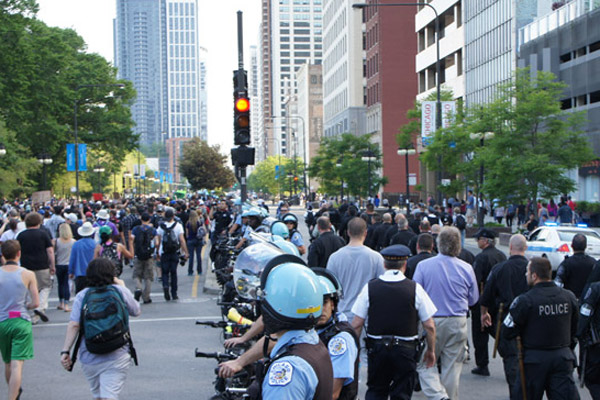
In the week before the NATO protests, the AP ran a very brief blurb on how Garry McCarthy and the CPD intended to keep order during NATO weekend. This one, I recall thinking, was encouraging:
EXTRACTION: Police Superintendent Garry McCarthy says officers will attempt to extract individual lawbreakers from crowds to keep problems from escalating. He says the department does not want to disperse crowds
The protests were well-documented from the side of the protesters; the Tribune has an in-depth look at the protests from the side of the police that explains, for example, why the march was briefly stopped on Michigan on Saturday as the unplanned march moved south:
To the south, police made a first attempt to get the group to stop in Congress Plaza, where some had rested at the end of marches the day before. They built a line of defense that included mounted officers.
[snip]
This time, police in riot gear backed up the horses, and things got tense as protesters demanded to pass through. They were bottled up as the crowd surged ahead, but officers eventually relented.
It was one of many times that protesters thought they had won a victory.
In fact, the standoff had actually been part of police strategy to buy precious time to move others into better positions up the street.
Holding ground while forces sprinted ahead to secure the next stretch of a march was all part of the training and planning police went through, McCarthy said.
The CPD was guided in part by officers off-site, communicating by radio to police on the street. This is in stark contrast to Seattle in 1999, the standing example for American cities for what not to do in the face of mass protests. The city's atrocious response cost the police chief his job, and the findings of the city council were critical, emphasizing a lack of both planning and communication within the department itself:
The city declared a “limited curfew” zone downtown, and defended its constitutionality in federal court. The declaration signed by the Mayor did not restrict what could be done in the area, and the city created a website explaining that protest activity was allowed.
But the curfew, in its application, became something quite different, and troubling. Although we could find no specific documents supporting the action, officers in the field were
briefed with instructions that there would be no protests allowed. Captain Jim Pugel, in his after action report, said that on the morning of December 1, 1999, “I was told there could be no protests in the restricted area”.
The city communicated one thing to protesters, another to officers. Chaos was inevitable. In a post mortem from the RAND Corporation, Paul de Armond describes a chilling breakdown of control within the department itself:
One clear sign of eroding police discipline was the circulation of mutinous talk regarding the “softness” of the official strategy for dealing with the demonstrators. During an October crowd-control training session, Assistant Chief Ed Joiner answered questions about protester violence by saying that there was nothing to worry about and the protests would be nonviolent. SPD Officer Brett Smith told the Seattle Post-Intelligencer that the FBI and Secret Service had briefed King County Sheriff’s officers to “fully anticipate that five to six officers would be lost during the protests, either seriously injured or killed.” By noon on Tuesday, the police chain of command was seriously eroding.
Seattle's post-riot findings also suggest why so many police (and state troopers) were brought in. Protesters, both during the march and on social media, declared "this is what a police state looks like"—and it did occur to me, seeing cops on practically every corner downtown, that the only place I'd ever seen that density of coverage was Havana, Cuba, where (at least a decade ago), it was hard to find a place where there were no cops within a line of sight.
But the Seattle City Council found that a comparative lack of cops encouraged police brutality and escalated tensions. Too few made the police fearful, more likely to preemptively strike out at protesters, and an inability to spell exhausted cops led to exhaustion and irritation, which led to poor judgement.
Some credit, however, is due for the protesters. In Seattle, mass arrests were part of the plan: 200-300 people, according to de Armond, intended to get arrested as an act of civil disobedience. This was achieved through lockdowns, chaining protesters together in order to shut down intersections, vastly increasing the logistical difficulties of the police and guaranteeing substantial physical contact between cops and protesters. The underprepared and understaffed SPD, unable to arrest the "arrest affinity groups," resorted to tear gas and pepper spray, which not only didn't help to clear the streets, it made things even worse, as legitimacy—"the extent to which the crowd feels that the police and the whole social order still deserve to be obeyed"—is crucial to crowd control. Had the SPD been properly trained and staffed, the nonviolent resistence may not have escalated into aggression. Here in Chicago, on Friday and Saturday, at least, the marchers showed cohesion, as roving organizers and medics lended a sense of structure and safety, mirroring the organization of the CPD.
Protests are odd things: they're reliant on a moving line between cooperation and antagonism separating the government and its dissidents. Much of this weekend was relatively peaceful, leaving suggestions for where that line should be drawn.



